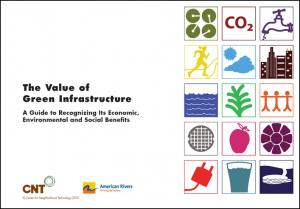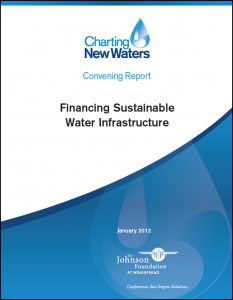Cost-effectiveness: Green vs. Gray
Reducing Stormwater Costs through Low Impact Development Strategies and Practices
U.S. EPA, 2007
This foundational set of 17 GI case studies by the EPA established that “in the vast majority of cases . . . implementing well-chosen LID practices saves money for developers, property owners, and communities while protecting and restoring water quality.” The 17 case studies evaluate project costs (not life-cycle costs) between green and gray solutions. Total capital cost savings with green over gray ranged from 15-80%. The study did not evaluate the additional economic benefits of GI that go beyond expected project performance, such as energy savings associated with installation of green roofs.
Available here.
Banking on Green: A look at how Green Infrastructure can save municipalities money and provide economic benefits community-wide
Requested by U.S. EPA, likely in preparation for their pending stormwater rules
Conducted by American Society of Landscape Architects, American Rivers, Water Environment Federation, and ECONorthwest, 2012
Broad analysis of 479 GI projects in order to quantify project cost savings. The study found that 75% of GI projects cost less than (44%) or equal to (31%) gray infrastructure solutions. All case studies are available for review.
Report available here.
Case studies available here.
Green Values Stormwater Management Calculator
Developed by the Center for Neighborhood Technology, 2009 with updates
Online tool “developed primarily for use by planners, engineers and other municipal staff.” This tool calculates lifecycle costs and benefits (i.e., costs and benefits over time) of competing green and gray solutions to user defined scenarios. The tool can be used at both the site and neighborhood levels.
Available here.
Rooftops to Rivers II: Green Strategies for Controlling Stormwater and Combined Sewer Overflows
Developed by the Natural Resources Defense Council, 2011
A detailed analysis of the benefits and economics of GI, policy recommendations at the local, state, and national level, and 14 detailed case studies, including projects in Milwaukee, Aurora (IL), Chicago, Detroit, and Syracuse (NY). This report also includes a literature review on GI economic benefits and financing in an appendix.
Available here.
“Additional” Economic Benefits of GI
The Value of GI: A Guide to Recognizing its Economic, Environmental and Social Benefits
Developed by the Center for Neighborhood Technology, 2010
A detailed workbook that guides the user through calculations to quantify the additional economic benefits of GI features. These are benefits that go beyond the primary purpose of the GI feature. For example, it helps the user calculate energy savings associated with green roofs or avoided cost associated with stormwater runoff and water quality. The workbook includes an appendix with many more resources.
Available here.
Economic Benefits of GI: Great Lakes Region (Ann Arbor, Milwaukee)
American Rivers and ECONorthwest, 2011
Application of the CNT “Value of GI” tool (above) to GI inventories in Ann Arbor and Milwaukee to quantify the additional benefits of GI features (i.e., those that go beyond expected project performance).
Though the inventory of GI features in Ann Arbor that was evaluated was small at the time (Mary Beth Doyle Park wetland, two green streets, and 50 rain gardens), and therefore additional GI benefits totaled to merely $100 million NPV over 50 years, the valuation process itself is informative.
Benefits at the community-wide or regional scale are seen to be most substantial. The report concludes, therefore, that “if all costs are borne by the individual site owner . . . market forces alone, without public regulatory or incentive-based intervention, are unlikely to lead to levels of GI” that maximize its potential.
Available here.
GI Funding Sources
U.S. EPA list on federal and regional funding sources and funding strategies
Provides links to many federal programs that have been used to fund GI projects and initiatives. The site also provides links to various tools for evaluating funding options.
Access the website here.
The site includes a link to the “Funding Options” portion of EPA’s Green Infrastructure Municipal Handbook (PDF, 1MB).
Financing Sustainable Water Infrastructure
Produced by the Johnson Foundation at Wingspread, 2012
This report is the culmination of a series of meetings of influential U.S. water infrastructure professionals hosted by the Johnson Foundation. The upshot is a strong recommendation to reduce reliance on state and federal funding for water infrastructure and to utilize “more cost-effective, resilient and environmentally sustainable systems.” A decade ago, the funding gap for water infrastructure was in the hundreds of billions; today it is likely greater. New funding streams must emerge. These can be brought about by . . .
- Creating local incentives or regulations to support LID
- Include additional benefits of GI (see “Value of GI” tool above)
- Account for the full life cycle cost of gray infrastructure (see “Green Values Calculator” above)
- Properly value ecosystem services
- Improve monitoring to improve efficiency
- Decentralize water infrastructure through GI










